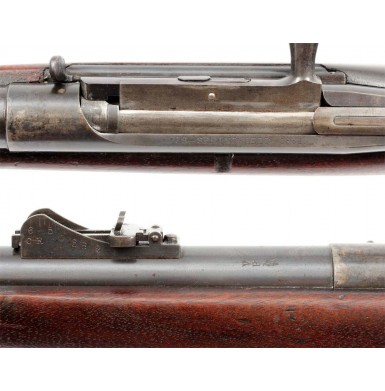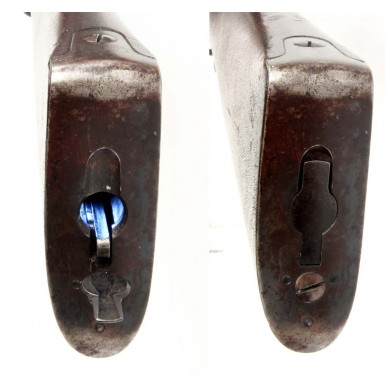Chaffee-Reece M-1882 Rifle - Outstanding
- Product Code: FLA-2101-SOLD
- Availability: Out Of Stock
-
$1.00
Almost as soon as the M-1873 “Trapdoor” rifle was adopted for service, the US Army started to look for its replacement. This is somewhat ironic, as the “Trapdoor” in its various model variants from the M-1873 through the M-1888 remained in general service through the Spanish American War of 1898 and the Philippines Insurrection of 1898-1899! The Army seemed to be very pleased with their 45-70 Government cartridge, but was interested in finding a better rifle to fire it from. The first option to see field-testing was the US M-1875 Lee Vertical Action Rifle, followed in 1878 by the 1st Model Hotchkiss Rifle; the first magazine fed, bolt-action rifle to see trials. Neither, however, was found to be the gun to replace the “Trapdoor”. In 1882 a Board of Ordnance committee was formed to evaluate potential candidates for a magazine fed that should be acquired in sufficient numbers to see field trials. Over 50 arms were submitted and saw initial testing, and the board found that the submitted designs from Lee, Chaffee-Reece and Hotchkiss were the most promising. The result was the acquisition and field-testing of the US M-1882 Lee Magazine Rifle, the US M-1882 Chaffee-Reece Magazine Rifle and the 3rd Model Hotchkiss Rifle. 750 each of the Lee and the Hotchkiss rifles were obtained for field trials, and 753 of Chaffee-Reece Rifles manufactured by Springfield Arsenal for field trials. The Colt Patent Firearms Manufacturing Company had produced the original Chaffee-Reece test rifle, but when Colt was approached to manufacture the arms for field trials, the Ordnance Board was quoted the astronomical price of $150.00 per rifle (about $3,400.00 per rifle at 2013 prices)! Additionally, Colt would only produce 200 of the rifles, not the required 750. As a result, the Ordnance Board approached the Springfield Arsenal to produce the Chaffee-Reece design. Springfield modified equipment on hand, left over from the manufacture of the experimental M-1871 Ward Burton Rifle, and produced 753 US M-1871 Chaffee-Reece Rifles at a price of $56.28 each (about $1,280.00 in todays money), about 1/3 of what Colt had bid to produce them!
The Chaffee-Reece (often misspelled “Reese” by even the most reliable and well known of authors and researchers) was a bolt-action, magazine fed rifle, chambered for the 45-70 Government cartridge. The rifle held 6 cartridges in the magazine tube in the buttstock and one in the chamber. The magazine was loaded through a trap in the butt, and the bolt had to be open to release the pressure on the feed device to allow it to open. Rather than a spring feed magazine, the Chaffee-Reece design used a ratcheting cartridge feeder that pushed a new cartridge forward each time the bolt was worked. A small lever, mounted on the forward right side of the receiver activated a magazine cut-off, which allowed the rifle to be fired as a single shot rifle. This held the contents of the magazine in reserve for rapid fire when necessary. The 9 pound, 9 ounce rifle (empty weight) had a 27 7/8” long blued barrel, secured by two spring retained, solid barrel bands. The upper band held a sling swivel and a stacking swivel, with the lower swivel being mounted on the triggerguard bow. The adjustable, long-range rear sight was of the US M-1879 pattern (as used on the M-1879 Trapdoor), but was graduated for the ballistics of the Chaffee-Reece and was marked C-R on the left side. All of the metal was blued, with a case hardened receiver that had a smoky blackish-gray color and a bright bolt. The front sight doubled as a bayonet lug for an angular socket bayonet. The guns were marked on the receiver US “ SPRINGFIELD “ 1884., and at the breech with the usual V / P / (EAGLE HEAD) proof marks. The guns were not serial numbered. The stock was marked with an inspectors’ cartouche at the upper right corner of the reverse buttstock, with the inspectors’ initials over the date 1884. A P (within a circle) firing proof was struck behind the triggerguard in the stock.
The Chaffee-Reece rifles entered field service for testing in late 1884 and was met with generally negative reviews. 95 reports on the rifles were received from the field during the trials, with only 14 of the reports reflecting that the Chaffee-Reece was superior to the current Trapdoor system or the other 2 magazine rifles then being tested. The rifles saw service with elements of US 8th, 9th, 14th, 15th , 19th, 23rd & 25th Infantry, as well as the 1st US Artillery. Although some of the reports lauded the magazine system of the rifle and some commended its accuracy, most reports were not positive. The primary complaint was that the butt magazine system weakened the stock significantly and made it susceptible to breakage. Other complaints revolved around the difficulty to keep the gun clean (making the bolt difficult to open and close), the heavy trigger pull (making accurate shooting difficult), the difficulty in performing the manual of arms with the rifle, and the poor performance with reloaded ammunition in the guns. By the end of the first quarter of 1886, the Chaffee-Reece rifles were returned to the Ordnance Department stores and were replaced by US M-1884 Trapdoor rifles. Over the next couple of decades the stocks of Chaffee-Reece rifles were sold off, with functional rifles being sold for less than 10% of what the guns had originally cost. Many of the guns had damaged stocks or were not functional, and these guns were sold at scrap metal prices.
This is NEAR EXCELLENT example of the US M-1882 Chaffee-Reece Magazine Rifle. The rifle is 100% complete, correct and original. The top left edge of the receiver is clearly marked in a single line: US “ SPRINGFIELD “ 1884.. The left barrel breech area is crisply marked: V / P / (EAGLE HEAD). The barrel retains about 95% of its original blued finish, with some very minor thinning, fading and light wear. Most of the wear and finish loss is along the high edges, the muzzle were the bayonet was fixed, and areas that were handled a significant amount. There is some very minor lightly oxidized freckling scattered along the barrel. The receiver retains about 60%-70% of its original blue, with some fading, thinning and loss, most noticeable above the rear of the chamber, just forward of the bolt recess. The barrel and receiver show no pitting, and only some very lightly scattered areas of very minor peppering and light pinpricking. The bolt has a medium smoky gray patina, and is a combination of dulled bright metal and lightly oxidized age discoloration. The barrel bands both show fading and light to moderate finish, loss, with the upper band retaining about 70%+ blue and the lower band retaining about 40%+. The triggerguard retains about 60%-70% original blue, with scattered minor surface roughness and oxidation along the rear tang of the triggerguard. This area should probably be carefully cleaned to prevent pitting and scoring of the metal over time. The buttplate retains about 50% faded and thinning blue, mixing with a plum-brown patina and patches of pewter gray metal. The butt trap magazine door opens, as it should, when the bolt is open. If the bolt is closed, it keeps the magazine door closed as well, a function of the cartridge feed system. The gun is mechanically fine and the cartridge feed mechanism appears to be complete and fully functional. The cartridge cut-off selector switch appears to function correctly as well. The bore of the rifle rates about VERY FINE+ to NEAR EXCELLENT. The bore is mostly bright, with crisp rifling. The bore shows only some light frosting in the grooves, and some lightly scattered pinpricking along its length. The rifle retains its correct and original C-R marked M-1879 pattern rear sight and both of its original sling swivels, as well as the stacking swivel. The original full-length cleaning rod is also in place in the ramrod channel under the barrel. The stock of the rifle rates NEAR EXCELLENT as well. The stock is full-length, solid and free of any breaks or repairs. The stock is clearly marked at the upper rear of the reverse butt with an inspection cartouche that reads: SWP /1884. “SWP” were the initials of Springfield Armory’s Master Armorer Samuel W. Porter. Porter had gone to work at Springfield in 1856 as a toolmaker, and rose to the position of Master Armorer in 1879 (replacing the famous Erskine S Allin) and remained in that position until his death in 1894. The cartouche is appropriately dated 1884, as all Chaffee-Reece rifles should be. The Springfield P (within a circle) firing proof is stamped clearly in the wood behind the triggerguard. The obverse of the stock is marked with the number 11, stamped upside down, under the receiver. This might have been a marking might have been applied by the regiment that handled this gun in field trials, allowing them to note any performance data about this specific rifle. The stock does show the expected scattered light bumps, dings and handling marks, but is free of any significant wear and shows no signs of abuse. The stock still retains the large majority of its original military oiled finish, with a lovely open grain showing that has never been sanded.
Overall this is a really fantastic example of a very rare US trials bolt-action, magazine fed rifle. With only 753 of these rifles produced, and many damaged during the course of field trials, this is a rifle that is difficult to find in such a fine state of preservation. Whether you collect early American military bolt action rifles, arms of the Indian Wars period, or just high condition US martial arms, this wonderful US M-1882 Chaffee-Reece with be a fantastic addition to your collection. The condition of the rifle and bore also suggest that it might be fun to put at least a few 45-70 rounds (black powder only!) downrange, just to see how it shoots.
SOLD







